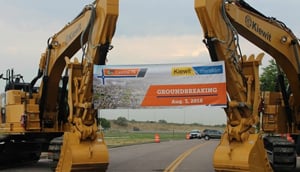 Think of the growing infrastructure projects across American cities. These developments are at times so costly that taxpayer money alone cannot fund them. That’s especially true in states like Colorado, where the population has grown 13% since 2010, making it the seventh fastest-growing state in the nation.
Think of the growing infrastructure projects across American cities. These developments are at times so costly that taxpayer money alone cannot fund them. That’s especially true in states like Colorado, where the population has grown 13% since 2010, making it the seventh fastest-growing state in the nation.
Public-private partnerships (P3) projects are another way to get additional funding for infrastructure developments. Contractors and their sureties must be ready to embrace this new model of project delivery.
Here are three current P3 projects in Colorado:
- I-70 corridor in Denver. Termed the “Central 70 Project,” this is a reconstruction of a 10-mile stretch of I-70 in Denver. Kiewit Meridiam Partners (KMP) is leading the $1.2 billion project. KMP will design, build and finance the reconstruction, while also operating and maintaining it for 30 years — a project the Colorado Department of Transportation calls the largest infrastructure initiative in Colorado’s history.
- Colorado State University (CSU) and the Western Stock Show Association. Denver is working with CSU and the association on a $1 billion transformation of the university’s campus, with the city’s portion amounting to $765 million. However, later phases of construction are still unfunded. The city and county of Denver are currently in procurement for these projects.
- Denver International Airport. In 2017, the airport secured a 34-year, $1.8 billion contract with Great Hall Partners, led by Ferrovial Airports. Approved by Denver city council last year, the P3 project consists of a $650 million renovation of the airport’s terminal, including the relocation of its screening area.
Before 2019, there were no state regulations in Colorado requiring P3 projects to be bonded. That has changed. The Rocky Mountain Surety Association and the Colorado Contractors Coalition led an effort to amend the state and local government Little Miller Act to require bonding for P3s. The National Association of Surety Bond Producers and The Surety & Fidelity Association of America worked with subcontractors in drafting the bill, which passed the Senate and House this year.
Here’s why underwriters at Old Republic Surety believe bonding a P3 project is important:
- To protect everyone
Before providing a bond, the surety evaluates the contractor’s expertise in the work, ability to work in the region where the project is located, all the jobs that the contractor currently has, and the contractor’s overall management and financial standing to complete the contract, including its capital and record of paying its obligations. Only a contractor that is capable of performing the work will be bonded. - Guarantees completion
The performance bond guarantees that the public works project is completed according to the construction contract. If a performance bond is not provided, the public entity and its taxpayers take on the risk should the contractor default, and they bear the burden of paying excess completion costs. They cannot be estimated with certainty, but completion costs for a defaulted project typically are higher than anticipated. By contrast, when a performance bond is in place, the full amount of the bond is available to complete the construction contract in the event of the contractor’s default. - Promises payment
The payment bond guarantees laborers, subcontractors and suppliers that they will get paid for their work and materials. Payment bonds are a critical protection for small, emerging and minority contractors, since they are more likely to start as subcontractors on projects. Without bonds, subcontractors and suppliers must either risk losses from nonpayment that they cannot afford, or not work on the public jobs for which they are qualified.
Construction is a risky business. Assurance of performance and payment is necessary. It’s vital for surety bonds to be in place to guarantee that these projects will be completed in a timely manner, that everyone will get paid and the project is completed to the specifications in the contract.
In the end, P3 projects are for the public use and public benefit. The main concern of a public entity is whether the public works project will be available for the public to use and whether subcontractors and suppliers will be paid. That interest is the same no matter if the public works project is delivered through a P3 or a more traditional method of procurement. As such, the construction portion of a P3 should be the same as for any other public works project.
Topics

Vicki Price is the Assistant Bond Manager for the Old Republic Surety Denver Branch.


